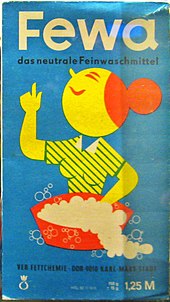VEB Fettchemie Chemnitz
| VEB Fettchemie and Fewa-Werke Chemnitz VEB Fettchemie Karl-Marx-Stadt |
|
|---|---|
| legal form | publicly-owned business |
| founding | 1948 |
| Seat | Chemnitz , Germany |
| Number of employees | 2500 (1980s) |
| Branch | Chemical industry |
The VEB fat chemistry (formerly H. Th. Böhme AG or Boehme fat chemistry GmbH ) was a major chemical company based in Chemnitz and other production sites in Mohsdorf , Oberlichtenau , Zwickau , Dresden and Hirschfelde . In addition to detergents and dishwashing detergents ( Fewa , fit ), it mainly produced chemical additives for the paper, leather and textile industries.
Company history
prehistory
The company went back to a "drug, paint and chemical product dealership" founded by Hermann Theodor Böhme in 1881 . In 1908 he bought a piece of land in Kappel, which was then still on the outskirts , in order to build a chemical factory for the production of finishing agents, textile oils and soaps. After Boehme's death in 1909, the company was converted into a family stock corporation (H. Th. Böhme AG) . After Heinrich Bertsch invented the first fully synthetic detergent Fewa in 1932 , the company expanded considerably and in 1934 it was converted into Böhme Fettchemie GmbH with the financial participation of the Düsseldorf-based Henkel Group . The number of employees rose to over 900 by 1938.
Development in the GDR

After the referendum in Saxony in 1946 , the company was expropriated and renamed VEB Fettchemie and Fewa-Werke Chemnitz in 1948 (from 1956: VEB Fettchemie Karl-Marx-Stadt ). As part of the central direction of the East German chemical industry fat chemistry changing was associations of nationally-owned enterprises (VVB) allocated from 1980 it belonged to combine household chemistry Genthin and from 1984 finally to the chemical combine Bitterfeld . At the same time, further parts of the company were added to it over time. At the end of the 1980s, Fettchemie had a total of 2500 employees, 1800 of them at the main plant in Chemnitz.
Development after the reunification
In 1990 VEB Fettchemie was again converted into a corporation, but the main factory was classified by the Treuhandanstalt as not fit for renovation and was shut down by the end of 1991. Part of the workforce was transferred to a rescue company, which began with the demolition and soil renovation of the 8.5 hectare company premises. The Solaris Group has been converting and marketing the area into a technology park since 1992 . The conversion concept was recognized as a "global project" at Expo 2000 .
More locations
- Dresden-Gittersee : originally belonged to SDAG Wismut or the Wolfen film factory , since 1963 to fat chemistry, produced a. a. Raw materials for the pharmaceutical industry
- Dresden-Neustadt (VEB Dresden-Chemie): was founded in 1879 by Adolf Theodor Böhme (brother of H. Th. Böhme), after 1945 part-state and in 1972 nationally owned, from 1976 part of oleochemicals, mainly produced aids for textile finishing
- Hirschfelde : After the fit washing-up liquid had already been brought onto the market in 1955 , VEB Fettchemie took over part of the former Hercules lignite plant in Hirschfelde near Zittau in 1967 and set up a liquid washing-up liquid plant there. In 1984 the plant was incorporated into the Leuna Kombinat , privatized after 1990 and now operates as fit GmbH .
- Oberlichtenau : Former wax factory, bought by H. Th. Böhme around 1896 and used initially as a raw material store, later also as a production facility.
- Mohsdorf : The former twisting mill was taken over by Böhme Fettchemie in 1926 and expanded into a chemical factory. In 1993, it was taken over by the specialty chemicals company Zschimmer & Schwarz , also from Chemnitz .
- Zwickau: founded in 1884 as a chemical factory by Theodor Rotta, expropriated in 1946 and initially subordinated to VVB “Sapotex”, from 1950 part of the fat chemistry division; mainly produced leather and textile auxiliaries, impregnation agents, dyeing and printing auxiliaries, bought back from Rotta's heirs after 1990 (2007 to 2018: Loser Chemie GmbH)
Exhibition stand at the Leipzig trade fair in 1951
Social, culture and sport
As early as the 1920s, what was then Böhme Fettchemie began offering social support services for the workforce. In the 1930s, under the umbrella of the German Labor Front, cultural activities such as B. promoted a marching band or a company library. In the GDR, in-house supply facilities such as B. kindergartens, holiday homes, a vocational school and a cultural center. The company sports association "Fewa Chemnitz" was one of the largest in the region and is considered to be the nucleus of today's Chemnitzer FC .
literature
- Jörg Feldkamp (Ed.): The Chemnitzer Fettchemie. From soap and drug dealers to chemical companies. (= Leaflet accompanying the exhibition from September 28 to November 16, 1997), Industriemuseum Chemnitz 1997.
Web links
- VEB Fettchemie files in the Chemnitz State Archives
- VEB Fettchemie on industrie-kultur-ost.de
Individual evidence
- ↑ Jörg Feldkamp (Ed.): Die Chemnitzer Fettchemie , p. 33.
- ↑ Jörg Feldkamp (Ed.): Die Chemnitzer Fettchemie , p. 9.
- ↑ From oleochemistry to Solaris: The Story of an Industrial Site. Retrieved August 18, 2017 .
- ^ The Solaris Expo project. Retrieved August 18, 2017 .
- ^ German Pavilion - Worldwide Projects. Retrieved August 22, 2017 .
- ↑ Zschimmer & Schwarz Group | Mohsdorf site. Retrieved August 18, 2017 .
- ^ Location - Loser Chemie. Retrieved August 27, 2017 .
- ↑ Jörg Feldkamp (Ed.): Die Chemnitzer Fettchemie , p. 34.
- ↑ Jörg Feldkamp (Ed.): Die Chemnitzer Fettchemie , p. 37 f.
Coordinates: 50 ° 49 ′ 7.9 ″ N , 12 ° 53 ′ 13 ″ E




